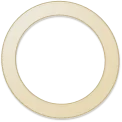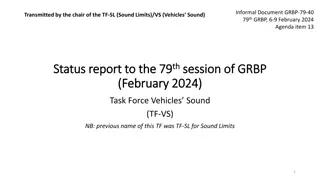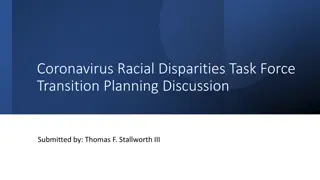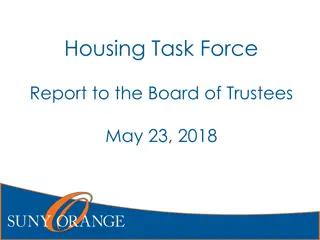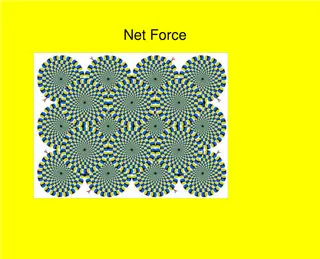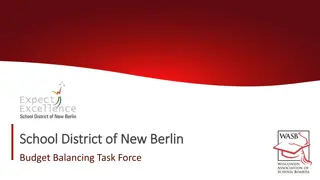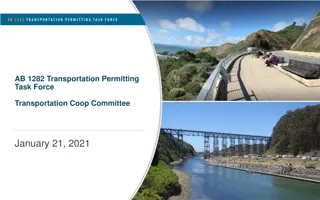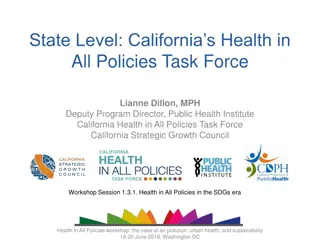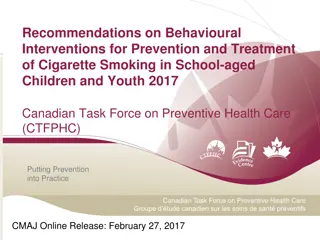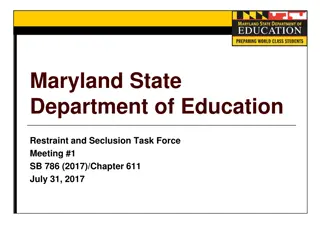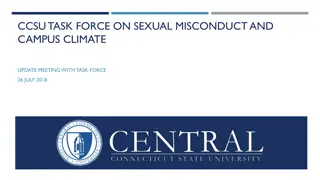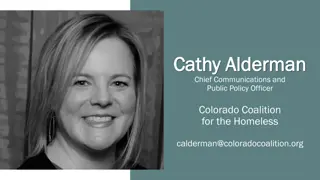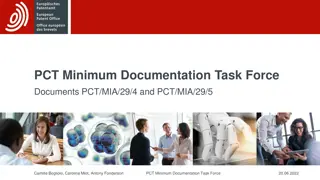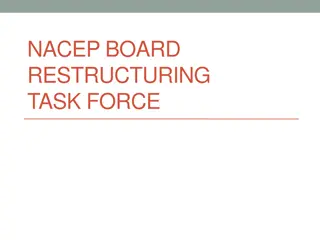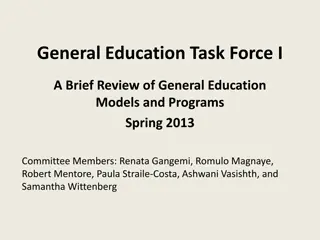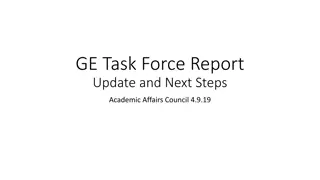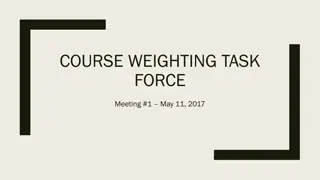Task Force on Review of School Curriculum Initial Recommendations
The Task Force on Review of School Curriculum has provided initial recommendations focusing on enhancing students' capacity to learn, catering to diverse abilities and aspirations, promoting whole-person development, and articulating learning at primary and secondary levels. The recommendations include creating space for learner diversity, values education, and promoting STEM education. The emphasis is on holistic curriculum planning to foster balanced development across various domains and provide a conducive learning environment. The progress report highlights engagement with key stakeholders and aims to finalize recommendations by early 2020.
Download Presentation

Please find below an Image/Link to download the presentation.
The content on the website is provided AS IS for your information and personal use only. It may not be sold, licensed, or shared on other websites without obtaining consent from the author. Download presentation by click this link. If you encounter any issues during the download, it is possible that the publisher has removed the file from their server.
E N D
Presentation Transcript
Task Force on Review of School Curriculum Initial Recommendations Dr Anissa CHAN 6 January 2020
Main Scope of Work To curricula and to make directional recommendations on the following: 1. how the school curricula at primary and secondary levels can be rigorous and forward-looking in enhancing students capacity to learn and instill in them the values and qualities desired for students of the 21st century to meet future challenges as well as the needs of society; 2. how to better cater for students diverse abilities, interests,needs and aspirations; 3. how to optimise the curriculum in creating space and opportunities for students whole-person development;and 4. how to better articulate learning at the primary and secondary levels. holistically review the primary and secondary 2
Progress Report Examined implementation in Hong Kong in the wider context of regional developments Continuously engaged key stakeholder groups and collected their views Formulated a set of categorised under six consultation (28 June 16 Oct 2019) after in-depth discussion on the views and suggestions collected Will finalise the directional recommendations and submit them to the Government by the end of 2019 or early 2020 the present state of curriculum initial directions recommendations for public 3
Initial Recommendations Whole-person Development Values Education Creating Space & Catering for Learner Diversity Applied Learning University Admissions STEM Education 4
Whole-person Development Enhance curriculum planning to create space and provide a wider range of learning experiences to foster students balanced development of attributes in the moral, intellectual,physical,social and aesthetic domains Create adequate space for students to participate in life-wide learning activities to develop personal strengths/interests (Provision of Life-wide Learning Grant from the 2019/20 school year) Make better use of whole-day primary schooling and flexibly plan learning time at the secondary level, and step up communication with parents and home- school co-operation to provide students with a learning environment conducive to whole-person education 5
Examples of Life-wide Learning Activities Cross-curricular/ theme-based learning Visits Non-local learning activities Education/training camp Drama/Film appreciation Competitions Sports and arts activities 6
Values Education Accord higher priority to values education to keep pace with rapid societal changes to address news issues in the digital era Strengthen Life Education in particular for cultivating students responsibility and ethical values Start Life Planning Education early at the upper primary and junior secondary levels to help students understand their interests, work ethics and career choices resilience, sense of 7
Creating Space & Catering for Learner Diversity Four core subjects at the senior secondary (SS) level: Keep intact the status of the four core subjects Review the design and implementation of the curriculum and assessment and take forward trimming and differentiation to increase curriculum flexibility and create space, hence catering for learner diversity 9
Initial Recommendation: optimising the Four Core Subjects at the SS Level Math Make it clear to schools a good mastery of concepts and skills in the Foundation Topics of the Compulsory Part will be sufficient to score as high as Level 4 in the HKDSE Exam Clarify and streamline the curriculum coverage with clear important concepts and content requirements Allow schools/students to opt out of the IES: assessment in the public exam alone can offer the highest attainment of Level 4 in the HKDSE Exam Liberal Studies delineation of the 10
Initial Recommendation: optimising the Four Core Subjects at the SS Level Chinese/ English Language Streamline the number of exam papers and/or SBA Enhance the learning of Chinese literature and classics in the curriculum from the primary level and progressively throughout the secondary level but need to consider how to cater for the learning needs of NCS students of diverse cultural background 11
Creating Space & Catering for Learner Diversity Current framework of the curriculum and assessment of core subjects Chinese Language English Language Liberal Studies Math Curriculum and Assessment Curriculum and Assessment Compulsory Extended Part (M1/M2) Modules + IES Part 12
Creating Space & Catering for Learner Diversity Possible scenarios of trimming and differentiating the core subjects Sufficient for Level 4 Chinese Language English Language Liberal Studies Math Foundation Topics Curriculum and Assessment Curriculum and Assessment M1/ M2 IES Compulsory Modules Non- Part foundation Topics Flexible choice Optional
Applied Learning Further promote Applied Learning (ApL) as a valued SS elective subject (e.g. Display and Jewellery Design) Creative Studies (e.g. Film and Transmedia) Media and Communication (e.g. Marketing and Online Promotion) Business, Management and Law (e.g. Child Care and Education) Services (e.g. Medical Laboratory Science) Applied Science (e.g. Aviation Studies) Engineering and Production 14
Applied Learning Increase students incentive to takeApL OfferApL as early as in Secondary 4; Relax funding eligibility for students taking ApL as the 4th elective subject; Provide a wider range ofApL courses; Offer taster programmes at the JS level;and Encourage tertiary institutions to recognise students achievements in ApL when considering them for admission 15
University Admissions Maintain General Entrance Requirements (GER) for university admissions (i.e. 3322 in the core subjects) Encourage universities flexibility in admitting students who demonstrate talents in non-academic areas or through other means but fall short of GER Encourage universities to expand the view on merit by giving greater weight to Student Learning Profile (SLP), Other Experiences and Achievements in Competitions/Activities (OEA) and School Principal s Nominations (SPN), and more widely adopting admission interviews to exercise greater 16
University Admissions The new School Principal s Nominations 2.0 Direct Admission Scheme (Initial Thought) Each secondary school can nominate two students (with outstanding talent in non- academic realms such leadership and social service) for designated university programmes. Subsequent to admission universities can provide nominees suitable for the applied programme before the release of the HKDSE results. Binding on both students and institutions once students have accepted the firm offer. (Remarks: Students who are not selected or do not accept the offer could apply for admission again via the JUPAS route.) as sports, arts, interviews, offer a firm for 17
STEM Education more clearly define STEM education and clarify the expectations of promoting STEM education in primary and secondary schools 18
STEM Education Promoting STEM education: Objectives Enable students to develop a solid knowledge foundation in Science, Technology and Math KLAs and arouse learning interest Enhance the ability to integrate and apply knowledge and skills Foster creativity, collaboration and problem solving skills, innovative thinking and entrepreneurial spirit Lay a foundation for students to pursue studies and careers in STEM-related fields With emphasis on the paradigm shift in learning and teaching and enhancing in particular: student-centred pedagogy enquiry learning hands-on and minds-on STEM activities, e.g. enquiry, design and make, project learning 19
Promoting STEM Education: Objectives Primary Junior Secondary Senior Secondary Develop a solid knowledge foundation in science, technology and math Skills in adopting scientific inquiry to acquire knowledge Skills in applying design thinking to create and problem solve Help students understand the latest developments in and importance of contemporary science and technology (e.g. artificial intelligence, biotechnology) Develop in students an interest in science and technology and a habit of applying design thinking to create and problem solve Develop in students a habit of applying knowledge and skills integratively to solve authentic problems Integrate the learning elements of STEM with existing subjects and enhance the integrated use of knowledge of science, technology and math to solve authentic problems Enable students to explore various STEM-related disciplines/careers and get prepared for planning future studies and work 20
STEM Education Step up professional support: Provide curriculum framework and/or guides as well as more learning and teaching exemplars; Enhance the professional capacity of teachers and principals through pre- and in-service training programmes; Appoint teachers to serve as STEM co-ordinators at both the primary and secondary levels; and Set up local STEM resources centres in different districts Set up a designated committee under the CDC to oversee the long-term development of STEM education in Hong Kong 21
Concluding Remarks Student needs are at the centre of this curriculum review. The initial recommendations fostering whole-person development , creating space , providing choice and meeting future needs and cultivating future-ready attributes . learning and development aim at 22
Concluding Remarks The recommendations are interlocking and their effective implementation, which helps create space for students and teachers and cater for diverse learning needs, hinges on the concerted efforts of all and a change in culture in schools and society. Whole-hearted, concerted efforts of various subjects and other stakeholders to make necessary compromises and changes in areas under their own purview with the aim of benefitting our students are crucial. 23




